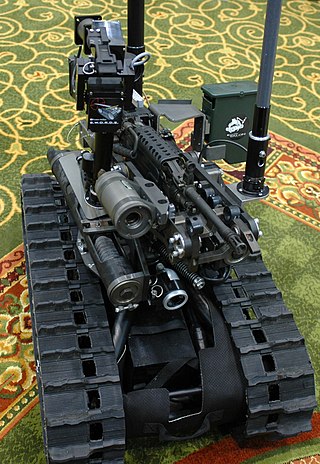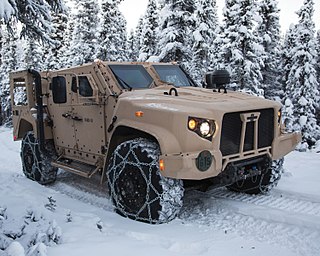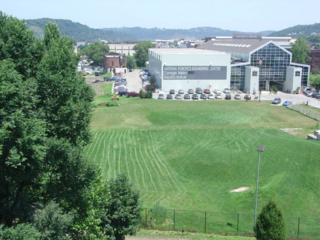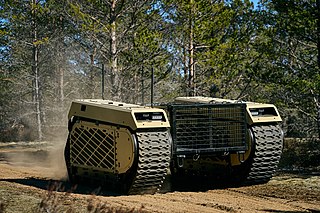Development
The Gladiator Program is a U. S. Marine Corps initiative based on the Joint Army-Marine Corps Tactical Unmanned Vehicle (TUV) ORD originated by the Infantry School. MNS INT 12.1.1, dated 4 November 1993, validated the need for a tactical unmanned ground vehicle system, and the Army approved the ORD in August 1995 and the Marine Corps in May 1996. Existing unmanned vehicles contained several deficiencies which caused both Army and Marine Corps developers to reevaluate design aspects. Developments of the Gladiator allow it to support dismounted infantry and aid in scout/surveillance, direct engagement, and obstacle-breaching missions.
The Marine Corps began development of the Gladiator by developing a Concept Validation Model (CVM) vehicle. The original concept for Gladiator was a vehicle that could provide reconnaissance, obscurant, and APOBS capabilities to the front-line Marines. The original vehicle size was set so that two Gladiators would be able to fit into the back of an HMMWV. The first version of Gladiator was developed by a team of Government Contract Companies located in the Huntsville, Alabama area but it was soon found that the requirement for two TUGVs to fit into a HMMWV made the original Gladiator CVM design top-heavy and impractical.
The Marine Corps changed the size requirement to one vehicle to fit into an HMMWV and moved development in 2002 to the Unmanned Ground Vehicles Technology Development group, headed by Robert Wade, at the Software Engineering Directorate located on Redstone Arsenal in Huntsville, Alabama. The GVTD team was led by mechanical engineer Keith Foslien (Government), systems and software engineer Brad Troyer (SAIC), electrical engineer Bill Brown (SAIC), fabrication Vince Davis (Government), and Mark Schulke (SAIC).
There were three Gladiator CVMs developed for the Marine Corps, the first was a diesel-powered tracked vehicle (shown above) while the other two were 6-wheeled hybrid electric vehicles. The original tracked CVM had a reconnaissance and weapon head, which were quickly combined into one head that could provide both functions. The capability of the vehicles increased over the three-year CVM program. The vehicles were able to support direct fire using the M240 & M249 machine guns, the UZI 9mm machine gun, and the FN303 less lethal weapon. They possessed night vision capabilities and could also geolocate a target and provide a firing solution to the operator for indirect engagement of the target. The Gladiator CVM was the first safe and successful weaponized TUGV in the world.
The Gladiator CVMs were used to develop and judge TUGV capabilities, requirements, and TTTTP with the input from the CVM program, and an RFP for Gladiator production went out to the industry. Upon the approval of the new design on February 7, 2005, Carnegie Mellon University's National Robotics Engineering Consortium and United Defense Industries were awarded a contract for over $26 million for the System Development and Demonstration (SDD) phase of the Gladiator. In 2007, six pre-production models were manufactured and the next step was to produce several hundred in production. The US Marines elected not to go into production with the units. These six prototypes were sent to the Army and later five of the six were placed into a CRADA between the Army and Cybernet Systems Corporation. Two of these units were refitted to full autonomous operations under a contract to develop the Unit-to-Unit Autonomous Resupply Vehicle (U2UARV). Among other changes to the Gladiator, the weapons platforms were removed and replaced with interfaces to carry JMIC pallets (Joint Modular Intermodal Containers).
Purpose
The Gladiator was designed with the intent to be easily transported to different parts of the battlefield. Adaptable to many types of environments, the Gladiator was to enhance the ability of Marines to accomplish assigned mission tasks. The purpose of the Gladiator was to be Tele operated just forward of the Marine units, performing basic scouting/surveillance, obstacle breaching, and reconnaissance tasks while permitting the operator to remain out of the line of danger.
The Gladiator TUGV is a robust, compact, unmanned, tele-operated, multi-purpose ground reconnaissance, surveillance, and target acquisition (RSTA) vehicle system possessing a scouting and direct engagement capability. It provides the armed forces with remote reconnaissance, surveillance, target acquisition, nuclear, biological, and chemical reconnaissance, obstacle breaching, and direct fire capability to neutralize threats and reduce risk to the warfighter. After refitting it for cargo carrying and autonomous operations over terrain and roads, it also provides small unit resupply features. The TUGV system can be utilized by infantry battalions and combat engineering companies. It's small enough to be strategically, operationally, and tactically deployed worldwide for ground, aircraft, and sea transport missions.

The AAI RQ-7 Shadow is an American unmanned aerial vehicle (UAV) used by the United States Army, Australian Army, Swedish Army, Turkish Air Force and Italian Army for reconnaissance, surveillance, target acquisition and battle damage assessment. Launched from a trailer-mounted pneumatic catapult, it is recovered with the aid of arresting gear similar to jets on an aircraft carrier. Its gimbal-mounted, digitally stabilized, liquid nitrogen-cooled electro-optical/infrared (EO/IR) camera relays video in real time via a C-band line-of-sight data link to the ground control station (GCS).

ISTAR stands for intelligence, surveillance, target acquisition, and reconnaissance. In its macroscopic sense, ISTAR is a practice that links several battlefield functions together to assist a combat force in employing its sensors and managing the information they gather.

An unmanned ground vehicle (UGV) is a vehicle that operates while in contact with the ground without an onboard human presence. UGVs can be used for many applications where it is inconvenient, dangerous, expensive, or impossible to use an onboard human operator. Typically, the vehicle has sensors to observe the environment, and autonomously controls its behavior or uses a remote human operator to control the vehicle via teleoperation.

The United States Marine Corps Reconnaissance Battalions are the special operations assets of Marine Air-Ground Task Force that provide division-level ground and amphibious reconnaissance to the Ground Combat Element within the United States Marine Corps. Division reconnaissance teams are employed to observe and report on enemy activity and other information of military significance in close operations. The Military Occupational Specialty code for Reconnaissance Marine is 0321.

The Multi-Mission Unmanned Ground Vehicle, previously known as the Multifunction Utility/Logistics and Equipment vehicle (MULE), was an autonomous unmanned ground combat vehicle developed by Lockheed Martin Missiles and Fire Control for the United States Army's Future Combat Systems and BCT Modernization programs. The last component of the program was canceled in July 2011.

The Foster-Miller TALON is a remotely operated, tracked military robot designed for missions ranging from reconnaissance to combat. It is made by the American robotics company QinetiQ-NA, a subsidiary of QinetiQ.
The BAE Systems Skylynx II is an unmanned aerial vehicle (UAV) developed to support US Marine Corps Tier II regiment-level reconnaissance, surveillance and target acquisition missions. The aircraft flew its maiden flight on August 9, 2006, at the Yuma Proving Grounds, Yuma, Arizona. The Skylynx II is equipped with an electro-optical (EO) and infrared imaging system, and during test flights it was able to locate and track human and vehicle targets. Powered by a UAV Engines UEL-741 engine driving a single propeller, the aircraft is designed to be launched without a runway, and to carry payloads of up to 70 lb (32 kg).

The Joint Light Tactical Vehicle (JLTV) program was a U.S. Army, U.S. Marine Corps and Special Operations Command competition to select a vehicle to partially replace the Humvee fleet with a family of more survivable vehicles having a greater payload. Early studies for the JLTV program were approved in 2006. The JLTV program incorporates lessons learned from the earlier Future Tactical Truck Systems program and other associated efforts.

The SWARM Remote Weapon System is a fully armored remote weapon system designed and built by the Thales Group in Glasgow, Scotland. The SWARM system consists of two main assemblies: the Gun Processing and Interface Unit (GPIU), which is operated inside the vehicle, and the external Weapon and Sensor Platform (WASP). It can fire a variety of weapons, and utilize multiple sensors. On the US Marine Corps' Gladiator Tactical Unmanned Ground Vehicle (TUGV), it is equipped with a 7.62 mm M240 and day/night sensors.
List of abbreviations, acronyms and initials related to military subjects such as modern armour, artillery, infantry, and weapons, along with their definitions.

Mesa Associates' Tactical Integrated Light-Force Deployment Assembly (MATILDA) is a remote controlled surveillance and reconnaissance robot, created and designed by the 'Mesa Robotics Corporation'. It is available in many different models such as the Urban Warrior, Block II, and Scout, which feature different combinations of components for increased utility. These options include a sensor mount, manipulator arm, weapon mount, fiber optic reel, remote trailer release, and disrupter mount. When purchased the basic system includes the platform, the control unit, and battery charger.

Special reconnaissance (SR) is conducted by small units, such as a recon team, made up of highly trained military personnel, usually from special forces units and/or military intelligence organizations. Special reconnaissance teams operate behind enemy lines, avoiding direct combat and detection by the enemy. As a role, SR is distinct from commando operations, but both are often carried out by the same units. The SR role frequently includes covert direction of airstrikes and indirect fire, in areas deep behind enemy lines, placement of remotely monitored sensors, and preparations for other special forces. Like other special forces, SR units may also carry out direct action and unconventional warfare, including guerrilla operations.
The reconnaissance mission within the United States Marine Corps is divided into two distinct but complementary aspects; Marine Division Recon and Force Reconnaissance.

The Ripsaw is a series of developmental unmanned ground combat vehicles designed by Howe & Howe Technologies for evaluation by the United States Army.
The Modular Advanced Armed Robotic System (MAARS) is a robot that is being developed by Qinetiq. A member of the TALON family, it will be the successor to the armed SWORDS robot. It has a different, larger chassis than the SWORDS robot, so has little physically in common with the SWORDS and TALON

The AN/TPS-80 Ground/Air Task Oriented Radar (G/ATOR) is the United States Marine Corps next-generation Air Surveillance/Air Defense and Air Traffic Control (ATC) Radar. The mobile active electronically scanned array radar system is being developed by Northrop Grumman and was expected to reach initial operating capability in August 2016.

The National Robotics Engineering Center (NREC) is an operating unit within the Robotics Institute (RI) of Carnegie Mellon University. NREC works closely with government and industry clients to apply robotic technologies to real-world processes and products, including unmanned vehicle and platform design, autonomy, sensing and image processing, machine learning, manipulation, and human–robot interaction.

Counter-IED equipment are created primarily for military and law enforcement. They are used for standoff detection of explosives and explosive precursor components and defeating the Improvised Explosive Devices (IEDs) devices themselves as part of a broader counter-terrorism, counter-insurgency, or law enforcement effort.

THeMIS, unmanned ground vehicle (UGV), is a ground-based armed drone vehicle designed largely for military applications, and is built by Milrem Robotics in Estonia. The vehicle is intended to provide support for dismounted troops by serving as a transport platform, remote weapon station, IED detection and disposal unit etc.














